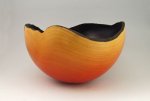Dave Hoskins
Member
- Messages
- 5,252
- Location
- Parker County, Texas
I finished this up yesterday just in time before the monsoons started again. I did this in several stages. After sanding the bowl to 400, that is what the bottle of dyes specify, I dyed the base and the rim with thinned down red. After that dried good then I did the whole bowl with thinned down blue. The dye I got is alcohol based so I used DNA to do the thinning. Also seems to be the only thing that will get the dye off of your hands seeing I'm not smart enough to have bought some plastic gloves. On the shopping list, just didn't think about them at first. After the blue dye dried I lightly sanded everything down trying to get a faded look from the red to the blue, or vice versa. I wanted a worn and rustic look to it. I think I accomplished it but would appreciate some comments from anyone who has played with dyes before. Or, comments from those who haven't. After the monsoons pass, which apparently is going to be a week off I will play with the dye some more after I get a few more stock items turned.





 One thing about dye is it will highlight any sanding scratches and tool marks, so you have to be very diligent about sanding them all away before applying the dye. (That's one reason I often dye only the outside of a bowl.) I'm seeing quite a few concentric marks on the inside of this piece...not sure if they're from tools or sandpaper. I suspect they may be spots where the wood has been burnished with the heel of the bowl gouge. When you sand, are you doing it with the lathe running? Are you using a power sander or doing it by hand? I've found for me the best way to get rid of tool/sanding circles is to use a power sander (I have a 2" ROS) with the lathe turned off.
One thing about dye is it will highlight any sanding scratches and tool marks, so you have to be very diligent about sanding them all away before applying the dye. (That's one reason I often dye only the outside of a bowl.) I'm seeing quite a few concentric marks on the inside of this piece...not sure if they're from tools or sandpaper. I suspect they may be spots where the wood has been burnished with the heel of the bowl gouge. When you sand, are you doing it with the lathe running? Are you using a power sander or doing it by hand? I've found for me the best way to get rid of tool/sanding circles is to use a power sander (I have a 2" ROS) with the lathe turned off.

